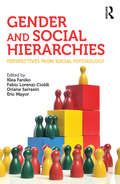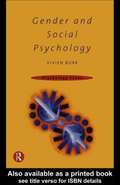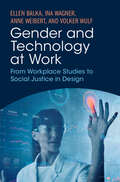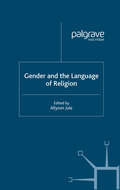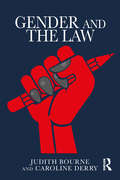- Table View
- List View
Gender and Social Capital (Gender Politics--Global Issues)
by Brenda O'Neill Elisabeth GidengilThe volume brings together a stellar group of contributors who examine the social capital thesis by means of four different approaches: theoretical, historical, comparative, and empirical. In the end, this book will serve to answer two fundamental questions which have hitherto been neglected: What can a gendered analysis tell us about social capital? And what can social capital tell us about women and politics?
Gender and Social Hierarchies: Perspectives from social psychology
by Eric Mayor Klea Faniko Fabio Lorenzi-Cioldi Oriane SarrasinGender and Social Hierarchies offers a fresh and coherent picture of applied research from within social psychology on the intricate relationship between gender and social status. It comprises a collection of innovative approaches which seek to understand the pervasiveness of status asymmetry between gender categories. Drawing upon recent theoretical advances in gender psychology, the book provides tools for developing practical and political recommendations to address and resolve status inequality today. Each chapter examines a different aspect of the impact that gender-based social hierarchies have on people’s lives. Part One explores the consequences of gender stereotypes in school, higher education, and in professional settings. The struggles faced by women in the workplace are discussed in Part Two, featuring topics such as work-life balance, the ‘glass cliff’, and the lack of support for affirmative action. Part Three is devoted to the antecedents and consequences of gender-based forms of prejudice, such as discrimination against gay men, and against women within cultural minorities. The book concludes with some practical suggestions for working towards lasting and beneficial change. Gender and Social Hierarchies will appeal to scholars and students across the social sciences and offers important insights to practitioners and policy-makers.
Gender and Social Hierarchies: Perspectives from social psychology
by Eric Mayor Klea Faniko Fabio Lorenzi-Cioldi Oriane SarrasinGender and Social Hierarchies offers a fresh and coherent picture of applied research from within social psychology on the intricate relationship between gender and social status. It comprises a collection of innovative approaches which seek to understand the pervasiveness of status asymmetry between gender categories. Drawing upon recent theoretical advances in gender psychology, the book provides tools for developing practical and political recommendations to address and resolve status inequality today. Each chapter examines a different aspect of the impact that gender-based social hierarchies have on people’s lives. Part One explores the consequences of gender stereotypes in school, higher education, and in professional settings. The struggles faced by women in the workplace are discussed in Part Two, featuring topics such as work-life balance, the ‘glass cliff’, and the lack of support for affirmative action. Part Three is devoted to the antecedents and consequences of gender-based forms of prejudice, such as discrimination against gay men, and against women within cultural minorities. The book concludes with some practical suggestions for working towards lasting and beneficial change. Gender and Social Hierarchies will appeal to scholars and students across the social sciences and offers important insights to practitioners and policy-makers.
Gender And Social Psychology
by Vivien BurrExplaining theory and research in an accessible but thorough manner, Gender and Social Psychology critically evaluates the contribution that psychology has made to the study of gender, examining key issues such a family roles and parenting, inequalities in education, jobs and pay, and the effects of media representation of the sexes.
Gender and Social Security Reform: What's Fair for Women?
by Neil GilbertAging populations are creating tremendous pressures on social security systems throughout the world, lifting the need for reform to the top of policy agendas. Proposed reforms often have different implications for men and women. At the same time, traditional family and gender roles are changing with the decline in fertility rates and the rapid rise in women's participation in the paid labor force.While trying to adapt social security systems to the fiscal demands of aging societies, policymakers face the compelling challenge of how to design pension reforms that achieve fair outcomes for women. Gender and Social Security Reform examines how different countries are attempting to meet this challenge. Drawing on comparative studies of European and Latin American countries along with a series of case studies of individual countries, the book provides insights into the gender dimensions of alternative designs for reform. All of the countries studied have recently reformed or are about to reform their pension systems, with a clear trend towards tightening the link between contributions and benefits in order to secure the long-term sustainability of pensions. The book also alerts policymakers to other issues: Should pension systems be gender-neutral or compensate for inequalities in paid and unpaid labor? Does compensation preserve gender discrimination? Are unisex life tables a reliable or fair redistributive tool for women? Or should annuities be linked directly to life expectancy, differentiated by sex and potentially other factors? Does a minimum pension guarantee risk compromising the principle of individual responsibility and work? How can recognition for caring work be balanced with work incentives? What can be done to help social security systems preserve freedom of choice in terms of work-family balance for women, men or the modem family unit as a whole?In analyzing the gender implications of recent social security policies and practices
Gender and Social Security Reform: What's Fair for Women? (International Social Security Ser.)
by Neil GilbertAging populations are creating tremendous pressures on social security systems throughout the world, lifting the need for reform to the top of policy agendas. Proposed reforms often have different implications for men and women. At the same time, traditional family and gender roles are changing with the decline in fertility rates and the rapid rise in women's participation in the paid labor force.While trying to adapt social security systems to the fiscal demands of aging societies, policymakers face the compelling challenge of how to design pension reforms that achieve fair outcomes for women. Gender and Social Security Reform examines how different countries are attempting to meet this challenge. Drawing on comparative studies of European and Latin American countries along with a series of case studies of individual countries, the book provides insights into the gender dimensions of alternative designs for reform. All of the countries studied have recently reformed or are about to reform their pension systems, with a clear trend towards tightening the link between contributions and benefits in order to secure the long-term sustainability of pensions. The book also alerts policymakers to other issues: Should pension systems be gender-neutral or compensate for inequalities in paid and unpaid labor? Does compensation preserve gender discrimination? Are unisex life tables a reliable or fair redistributive tool for women? Or should annuities be linked directly to life expectancy, differentiated by sex and potentially other factors? Does a minimum pension guarantee risk compromising the principle of individual responsibility and work? How can recognition for caring work be balanced with work incentives? What can be done to help social security systems preserve freedom of choice in terms of work-family balance for women, men or the modem family unit as a whole?In analyzing the gender implications of recent social security policies and practices
Gender and Technology at Work: From Workplace Studies to Social Justice in Design
by null Ellen Balka null Ina Wagner null Anne Weibert null Volker WulfThis book brings together the vast research literature about gender and technology to help designers understand what a gender perspective and a focus on intersectionality can contribute to designing information technology systems and artifacts, and to assist organizations as they work to develop work cultures that are supportive of women and marginalized genders and people. Drawing on empirical and analytical studies of women's work and technology in many parts of the world, the book addresses how to make invisible aspects of work visible; how to recognize women's skills without falling into the trap of gender stereotyping; how to engage in improving working conditions; and how to defend care of life situations and needs against a managerial logic. It addresses challenges for design, including many overlooked and undervalued aspects, such as the complexities involved in human–machine interactions, as well as the need to create safe spaces for research subjects.
Gender and the Changing Face of Higher Education: A Feminized Future? (UK Higher Education OUP Humanities & Social Sciences Higher Education OUP)
by Carole Leathwood Barbara ReadA notable feature of higher education in many countries over the last few decades has been the dramatic rise in the proportion of female students. Women now outnumber men as undergraduate students in the majority of OECD countries, fuelling concerns that men are deserting degree-level study as women overtake them both numerically and in terms of levels of achievement. The assertion is that higher education is becoming increasingly 'feminized' - reflecting similar claims in relation to schooling and the labour market. At the same time, there are persistent concerns about degree standards, with allegations of 'dumbing down'. This raises questions about whether the higher education system to which more women have gained access is now of less value, both intrinsically and in terms of labour market outcomes, than previously. This ground-breaking book examines these issues in relation to higher education in the UK and globally. It provides a thorough analysis of debates about 'feminization', asking: To what extent do patterns of participation continue to reflect and (re)construct wider social inequalities of gender, social class and ethnicity? How far has a numerical increase in women students challenged the cultures, curriculum and practices of the university? What are the implications for women, men and the future of higher education? Drawing on international and national data, theory and research, Gender and the Changing Face of Higher Education provides an accessible but nuanced discussion of the 'feminization' of higher education for postgraduates, policy-makers and academics working in the field.
Gender and the Creative Labour Market: Graduates in Australia and the UK
by Scott Brook Roberta Comunian Jonathan Corcoran Alessandra Faggian Sarah Jewell Jen WebbThis book describes the early career outcomes for female creative graduates in Australia and the UK. It applies the international UNESCO model of the Cultural and Creative Industries (CCIs) to national graduate destination survey data in order to compare creative women’s employment outcomes to those of men, as well as non-creative graduates. Chapters focus on opportunities for creative and cultural work, including salaries, geographic mobility, graduate jobs, underemployment, and skills transferability. The model covers a broad range of cultural and creative domains such as heritage, the performing arts, visual arts and craft, publishing and media industries, fashion, architecture and advertising. The book’s purpose is to provide an informed discussion and empirical report to key stakeholders in the topic, such as academic researchers, teachers and students, as well as cultural sector organisations and education departments.
Gender and the Language of Religion
by A. JuleThis book contributes to an understanding of the complex relationship of gender and language alongside religion and religious life as experienced by various religious groups around the world. The intention is to put forward current studies in the field of linguistics and explore how gender and various religions intersect with language use. The universal and diverse experience of religion provides for this unique collection of papers concerning the use of language in religious liturgy, in religious communities, and in interaction with identity. As such, the book will attract students and researchers in discourse, gender studies and religious studies.
Gender and the Law
by Judith Bourne Caroline DerryGender and the Law provides an ideal introduction to gender and feminist theory for students. Beginning with an overview of traditional notions of gender, the book establishes the key feminist and queer legal theories. It provides a basic structure and overview upon which students can build their understanding of some of the complex and controversial topics and debates around gender. Structured thematically, the book explores many fascinating and controversial legal issues, including issues of transgender rights; equal pay and equality in the workplace; societal changes and challenges within the regulation of personal relationships; the law surrounding consent and sexual offences; the role of gender norms in the criminal courts; legal regulation of prostitution and pornography; and the ways in which the law has responded to societal changes surrounding reproduction. With ‘thinking points’ and ‘further reading’ suggestions within each chapter, the authors encourage an engagement with critique and theory in order to understand this dynamic and challenging field.
Gender and the Law
by Judith Bourne Caroline DerryGender and the Law provides an ideal introduction to gender and feminist theory for students. Beginning with an overview of traditional notions of gender, the book establishes the key feminist and queer legal theories. It provides a basic structure and overview upon which students can build their understanding of some of the complex and controversial topics and debates around gender. Structured thematically, the book explores many fascinating and controversial legal issues, including issues of transgender rights; equal pay and equality in the workplace; societal changes and challenges within the regulation of personal relationships; the law surrounding consent and sexual offences; the role of gender norms in the criminal courts; legal regulation of prostitution and pornography; and the ways in which the law has responded to societal changes surrounding reproduction. With ‘thinking points’ and ‘further reading’ suggestions within each chapter, the authors encourage an engagement with critique and theory in order to understand this dynamic and challenging field.
Gender and the Male Character in 21st Century Fairy Tale Narratives: From Enchanted Heroes to Modern Masculinities (Emerald Studies in Popular Culture and Gender)
by Natalie Le ClueFrom the shady and complicated Rumpelstiltskin to the born-again hero of Captain Hook in Once Upon a Time, as well as films which magnify the male character such as The Huntsman: Winter’s War, Tangled, Frozen, and Tim Burton’s Alice in Wonderland, the male fairy tale character has received increased attention in fictional narratives over the past decade. For the first time, Gender and the Male Character in 21st Century Fairy Tale Narratives extends this attention into the realm of academic study. Featuring differing perspectives and disciplines, including gender, queer, fan, and television and film studies, chapters take an interdisciplinary approach to analyse male characters through lenses such as race, disability, class, religion, and sexuality. Contributors unveil alternative conceptualisations of ‘traditional’ male fairy tale characters, weaving a rich story of the interaction between popular culture, gender representation, power, and society. Putting Prince Charming in the academic spotlight, this collection examines the evolution of male fairy tale characters across modern series and films to bridge a gap that afflicts multiple disciplines.
Gender and the Male Character in 21st Century Fairy Tale Narratives: From Enchanted Heroes to Modern Masculinities (Emerald Studies in Popular Culture and Gender)
by Natalie Le ClueFrom the shady and complicated Rumpelstiltskin to the born-again hero of Captain Hook in Once Upon a Time, as well as films which magnify the male character such as The Huntsman: Winter’s War, Tangled, Frozen, and Tim Burton’s Alice in Wonderland, the male fairy tale character has received increased attention in fictional narratives over the past decade. For the first time, Gender and the Male Character in 21st Century Fairy Tale Narratives extends this attention into the realm of academic study. Featuring differing perspectives and disciplines, including gender, queer, fan, and television and film studies, chapters take an interdisciplinary approach to analyse male characters through lenses such as race, disability, class, religion, and sexuality. Contributors unveil alternative conceptualisations of ‘traditional’ male fairy tale characters, weaving a rich story of the interaction between popular culture, gender representation, power, and society. Putting Prince Charming in the academic spotlight, this collection examines the evolution of male fairy tale characters across modern series and films to bridge a gap that afflicts multiple disciplines.
Gender and the Nuclear Family in Twenty-First-Century Horror
by Kimberly JacksonGender and the Nuclear Family in Twenty-First-Century Horror is the first book-length project to focus specifically on the ways that patriarchal decline and post-feminist ideology are portrayed in popular American horror films of the twenty-first century. Through analyses of such films as Orphan, Insidious, and Carrie, Kimberly Jackson reveals how the destruction of male figures and depictions of female monstrosity in twenty-first-century horror cinema suggest that contemporary American culture finds itself at a cultural standstill between a post-patriarchal society and post-feminist ideology.
Gender and the Organization: Women at Work in the 21st Century
by Marianna Fotaki Nancy HardingDiscussions of feminism and gender in organizations and management studies, have, with some notable exceptions, become stuck in something of a time-warp. This lies in stark contrast to the developments in the fields of feminism and gender theory more generally. Management and organization studies needs new applied topical gender theories that challenge the limits on what can be said about working lives in organizations. Gender and the Organization: Women at Work in the 21st Century looks to update management organizational studies with the recent developments in gender theory, including theories of embodiment, affect, materiality, identity, subjectification, recognition, and the intertwining of political, social and the psyche. As well as looking backwards at existing feminist and gender theory, this exciting book also looks forward, developing an organizational feminist theory for the twenty-first century. Exploring what feminist ethics of an organization would look like, this volume shows what a revivified feminist organization studies could offer to gender theorists more generally. This book will be of interest not only to management and organization theorists, but also more generally to feminist and gender theorists working across the social sciences, arts and humanities. It will appeal to postgraduate and research students and also to established organization and management scholars working in business schools across the world.
Gender and the Organization: Women at Work in the 21st Century
by Marianna Fotaki Nancy HardingDiscussions of feminism and gender in organizations and management studies, have, with some notable exceptions, become stuck in something of a time-warp. This lies in stark contrast to the developments in the fields of feminism and gender theory more generally. Management and organization studies needs new applied topical gender theories that challenge the limits on what can be said about working lives in organizations. Gender and the Organization: Women at Work in the 21st Century looks to update management organizational studies with the recent developments in gender theory, including theories of embodiment, affect, materiality, identity, subjectification, recognition, and the intertwining of political, social and the psyche. As well as looking backwards at existing feminist and gender theory, this exciting book also looks forward, developing an organizational feminist theory for the twenty-first century. Exploring what feminist ethics of an organization would look like, this volume shows what a revivified feminist organization studies could offer to gender theorists more generally. This book will be of interest not only to management and organization theorists, but also more generally to feminist and gender theorists working across the social sciences, arts and humanities. It will appeal to postgraduate and research students and also to established organization and management scholars working in business schools across the world.
Gender and the Political: Deconstructing the Female Terrorist
by A. ThirdAnalyzing women labeled as terrorists in the United States in the late 1960s and early 1970s, Gender and the Political examines Western cultural constructions of the female terrorist. The chapters argue that the development of the discourse on terrorism evolves in parallel with, and in response to, radical feminism in the US during this time.
Gender and the Political Opportunities of Democratization in South Korea
by N. JonesThis book explores how political opportunities afforded by democratization, including the relative balance of power between conservative and progressive civic actors, shape power relations between men and women in post-authoritarian Korea. Jones reveals that organized women can make a difference - depending on their strategic choices and alliances, and the manner in which they negotiate evolving political institutions. Moreover, democratic consolidation need not be led by political parties, but can provide surprising opportunities for an organized civil society to press for a deepening of political and human rights.
Gender and the Politics of Rights and Democracy in Latin America (Women's Studies at York Series)
by Maxine MolyneuxThis volume assesses one of the most important developments in contemporary Latin American women's movements: the engagement with rights-based discourses. Organised women have played a central role in the continued struggle for democracy in the region and with it gender justice. The foregrounding of human rights, and within them the recognition of women's rights, has offered women a strategic advantage in pursuing their goals of an inclusive citizenship. The country-based chapters analyse specific bodies of rights: rights and representation, domestic violence, labour rights, reproductive rights, legal advocacy, socio-economic rights, rights and ethnicity, and rights, the state and autonomy.
Gender and the Politics of Welfare Reform: Mothers' Pensions in Chicago, 1911-1929 (Women in Culture and Society)
by Joanne L. GoodwinThe first study to explore the origins of welfare in the context of local politics, this book examines the first public welfare policy created specifically for mother-only families. Chicago initiated the largest mothers' pension program in the United States in 1911. Evolving alongside movements for industrial justice and women's suffrage, the mothers' pension movement hoped to provide "justice for mothers" and protection from life's insecurities. However, local politics and public finance derailed the policy, and most women were required to earn. Widows were more likely to receive pensions than deserted women and unwed mothers. And African-American mothers were routinely excluded because they were proven breadwinners yet did not compete with white men for jobs. Ultimately, the once-uniform commitment to protect motherhood faltered on the criteria of individual support, and wage-earning became a major component of the policy. This revealing study shows how assumptions about women's roles have historically shaped public policy and sheds new light on the ongoing controversy of welfare reform.
Gender and the Politics of Welfare Reform: Mothers' Pensions in Chicago, 1911-1929 (Women in Culture and Society)
by Joanne L. GoodwinThe first study to explore the origins of welfare in the context of local politics, this book examines the first public welfare policy created specifically for mother-only families. Chicago initiated the largest mothers' pension program in the United States in 1911. Evolving alongside movements for industrial justice and women's suffrage, the mothers' pension movement hoped to provide "justice for mothers" and protection from life's insecurities. However, local politics and public finance derailed the policy, and most women were required to earn. Widows were more likely to receive pensions than deserted women and unwed mothers. And African-American mothers were routinely excluded because they were proven breadwinners yet did not compete with white men for jobs. Ultimately, the once-uniform commitment to protect motherhood faltered on the criteria of individual support, and wage-earning became a major component of the policy. This revealing study shows how assumptions about women's roles have historically shaped public policy and sheds new light on the ongoing controversy of welfare reform.
Gender and the Politics of Welfare Reform: Mothers' Pensions in Chicago, 1911-1929 (Women in Culture and Society)
by Joanne L. GoodwinThe first study to explore the origins of welfare in the context of local politics, this book examines the first public welfare policy created specifically for mother-only families. Chicago initiated the largest mothers' pension program in the United States in 1911. Evolving alongside movements for industrial justice and women's suffrage, the mothers' pension movement hoped to provide "justice for mothers" and protection from life's insecurities. However, local politics and public finance derailed the policy, and most women were required to earn. Widows were more likely to receive pensions than deserted women and unwed mothers. And African-American mothers were routinely excluded because they were proven breadwinners yet did not compete with white men for jobs. Ultimately, the once-uniform commitment to protect motherhood faltered on the criteria of individual support, and wage-earning became a major component of the policy. This revealing study shows how assumptions about women's roles have historically shaped public policy and sheds new light on the ongoing controversy of welfare reform.

